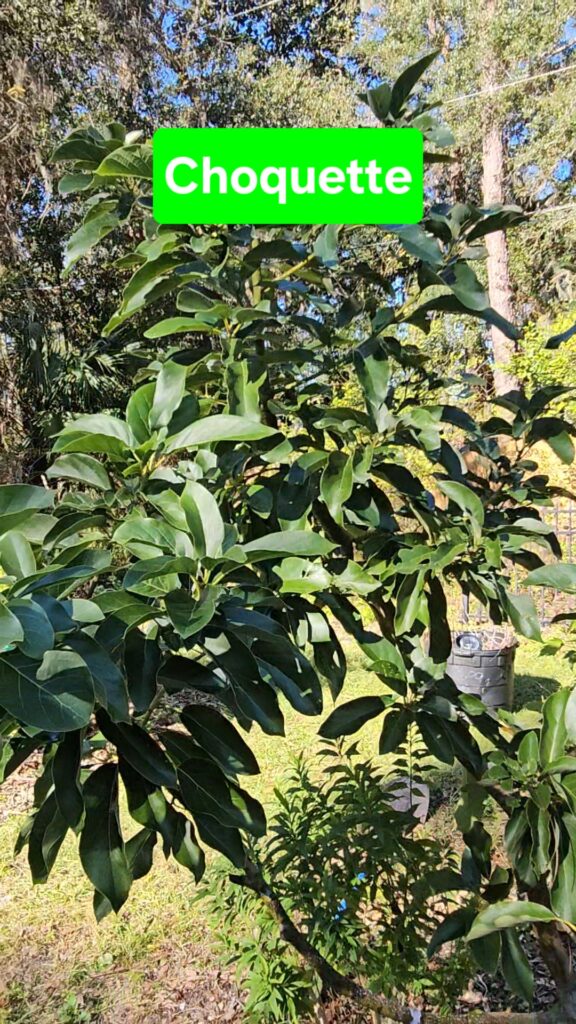Growing Choquette Avocado Trees in the Northeast Florida Landscape
Choquette Avocado Trees / Persea americana Origins:

– Choquette avocado is a Guatemalan x West Indian cross that has a Type A flowering schedule. It is considered a prolific or heavy producer of large 20-40 oz fruits and is a biennial bearing tree. Every other year it will have an extra large crop of tasty fruit! For collectors in Florida Choquette fills that late winter early spring harvest time that most others can not here in Northeast Florida, extending your avocado harvest season immensely when combined with early and mid season bearers. Every avocado enthusiast will want at least one in their collection! I may want two…I HATE having to buy grocery store avocados, and I’m normally running out of my own trees avocados by late January…after eating fresh from the garden avocados for the last 10 years, Haas from the grocery store…is just is a no for me, it almost hurts my heart. I bought two last Sunday. And its only the second week in January 🙁 So a second Choquette is in the budget plans with what I spend on Avocados from now till my first fruits this year, I could buy another two…but Id have to not eat avocados till then so…maybe one tree and cut back on avocados till mine are ready again? Sigh…
Choquette Avocado Tree Exposure:
– Choquette avocado trees should be planted into a full sun or afternoon sun location in the Northeast Florida landscape.
Choquette Foliage and Winter Cold Tolerance:
– Large light to medium green foliage, non scented. Remains evergreen in the winter.
Choquette avocado trees have a moderately high cold tolerance once they have matured they can withstand temperatures down to 25°F. Protect younger and newly planted trees from freezing temperatures. This variety should be given extra care when choosing placement sites in the landscape planting it on the south side of sheds and buildings, out of the north winds and making sure to keep it in frost free areas of your landscape. 25 degrees is a pretty tough avocado tree but we need to remember the cold tolerance of 25°F given is for established trees not for young or newly planted trees, that can be cutting it really close to loosing your young or new trees in colder areas of our NE Florida landscapes like the West side of Jax Callahan, Hilliard, Northside by the airport etc. For those of us in south Jax, mandarin, St. Johns,St. Augustine…its still a good idea to protect young trees if we get extended freezing temperatures and plant your Choquettes and other tropical plant selections in the spring to give them plenty of time to root in and get growing before a frost.
Choquette Soil Preference / Salt tolerance:
-Avocado trees need well drained soils. They are not tolerant of overly moist soils, avoid planting in areas that remain wet for days after heavy rains, plant in raised beds or berms in areas with a high water table. when planted into well drained soils avocados are well suited to the native sandy soils of Florida and do not require amendment at the time of planting.
– low salt tolerance not suitable for coastal gardens.
Choquette Avocado Tree Size Variance and Growth Habit:
– Choquette avocado trees are considered a larger fast growing cultivar for Northeast Florida’s landscapes. They reach 20-40 ft in height and have an 8-15 ft width. They will produce fruit best when kept to an open center by removing the central leader where sunlight can penetrate into the branch structure. This helps keep the trees fruit where you can easily reach it, helps get sunlight and air circulation into the inner branch structure and aids with any pest / leaf treatments you may need.
Choquette Avocado Tree Growth Rate:
– Avocado trees are considered a moderate to fast growing plant selection. Once established into the landscape expect 1-3 ft of foliage growth in a season. Choquette is going to be on the faster side of that range.
Choquette Avocado Tree Blooms and Fruit:
Choquette avocado trees follow the type A flowering schedule that open as female in the morning of the first day, remain open for a few hours and close late that afternoon. Those same flowers will then reopen as male in the afternoon of the second day.
–Choquette avocados are grown for their prolific bearing of high quality fruits. They have a high oil content (13%) and a mild nutty flavor with very large 20-40 oz fruits. Glossy dark green smooth thicker skin with an oval shape and an oval pointed interior pit. They are considered an alternate bearing tree or a biennial bearer, producing extra large crops every other year.
All avocado fruit ripens once it has fallen from the tree or has been picked. Once your Choquette avocado tree fruit has reached mature size you can pick them from January to March here in Northeast Florida and let them ripen indoors at will or leave them on the tree until you need them! If the fruit wrinkles up after letting them sit to to ripen the fruit was not finished maturing, leave them on the tree longer and try harvesting one again in a few weeks.
Avocado Water Requirements:
– Although much more durable once established in the landscape, regular water is necessary to get the plant rooted and growing on its own after being planted in the ground from an S & J Nursery container. Use supplemental irrigation when planted in full sun or in extremely sandy soil.
– Water generously during droughts at least once or twice a week for best results if
planted into an non irrigated garden location.
Care of Nishikawa Avocado Trees in the Northeast Florida Landscape:
– Its always best to trim an avocado just after harvesting. With Choquette, fortunately this will be in early spring! Make sure to fertilize at the same time you prune and water well for the next few weeks to ensure the tree has everything it needs to get growing.
– Avocado trees will need good water during the establishment period and
supplemental irrigation during dry spells or particularly hot dry summers, especially when planted into sandy soils.
– Fertilize your newly planted trees every other month through the year with a good tropical plant food or a slow release poly coated plant food such as Osmocote. This is especially important on newly planted and younger trees. Once the trees are well established and have been growing for a few years in your landscape you can reduce that to once a season, or 4 times a year.
– Keep the area below the foliage free of grass and other vegetation that will compete for nutrients. Mulch thickly in a circle around the tree under the foliage canopy being sure to keep it thinner not letting it pile up right at the base of the trunk. Start with at least a 4 ft wide circle on a young tree and you can keep expanding the mulch bed area to the foliage line as your tree grows. Arborist chips are ideal, you can also use other options like leaf litter from surrounding landscape trees, pine straw or pine bark all good sustainable options that will both help regulate soil moisture and break down into nutrition for your trees.
Bacon Avocado | Hardy to 24-26°F
Brazos Belle | Hardy to 15-18°F
Brogden Avocado | Hardy to 15°F
Choquette | Hardy to 22°F
Fantastic | Hardy to 15°F
Florida Haas | Hardy to 18°F
Fuerte Avocado | Hardy to 26° F
Hall Avocado | Hardy to 20°F
Joey Avocado | Hardy to 15°F
Lila Avocado | Hardy to 15°F
Lula Avocado | Hardy to 25°F
Marcus Pumpkin | Hardy to 20°F
Mexicola Grande | Hardy to 18°F
Monroe | Hardy to 25°F
Nishikawa Avocado | Hardy to unknown 25-28° F
Oro Negro Avocado | Hardy to 25-28°F rumor has it much lower
Pancho Avocado | Hardy to 15°F
Thompson Red | Hardy to 24°F
Winter Mexican Avoacado | Hardy to 18°F
Wurtz Avocado | hardy to 24°F

